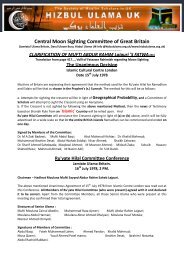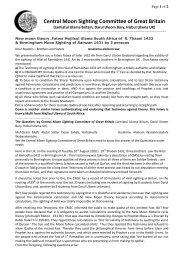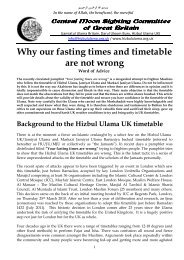article on Fajar and Isha observations by Dr ... - Hizbul Ulama UK
article on Fajar and Isha observations by Dr ... - Hizbul Ulama UK
article on Fajar and Isha observations by Dr ... - Hizbul Ulama UK
You also want an ePaper? Increase the reach of your titles
YUMPU automatically turns print PDFs into web optimized ePapers that Google loves.
zodiac c<strong>on</strong>stellati<strong>on</strong>s, hence its name. Its subtle radiance is most noticeable around the<br />
spring <strong>and</strong> fall equinoxes.<br />
Known <strong>and</strong> sometimes feared since ancient times, zodiacal light was recorded <strong>by</strong> many<br />
cultures. The Greek philosopher Aristotle c<strong>on</strong>cluded that these misty patches of lights in the<br />
heavens were caused <strong>by</strong> far-off volcanic erupti<strong>on</strong>s. First-century Romans likened them to the<br />
glows of distant unseen fires.<br />
In the 16th century, they were a more ominous associati<strong>on</strong> for the Aztec Empire <strong>and</strong> its ruler,<br />
M<strong>on</strong>tezuma. The king gave up his empire to Cortes <strong>and</strong> his army of Spanish c<strong>on</strong>quistadors in<br />
1519, in part because of the strange appearance of the ghostly pyramid-shaped light that<br />
M<strong>on</strong>tezuma described as a threatening "vast flood of sparkling fire."<br />
The night skies aren't totally dark. At times, sunlight or mo<strong>on</strong>light reflects off high-altitude<br />
clouds, causing a degree of brightness in the starry skies. And dark locati<strong>on</strong>s still offer<br />
glorious views of a b<strong>and</strong> of light running across the overhead sky. This is actually the light<br />
from billi<strong>on</strong>s of stars that make up our own Milky Way galaxy.<br />
But in fact, about 40 per cent of the overall light in the night sky can be attributed to this<br />
zodiacal dust cloud. Sometimes known as the "afterglow of the day," it is often c<strong>on</strong>fused<br />
with twilight, which uniformly encompasses most of the western sky.<br />
Few people today have c<strong>on</strong>sciously observed this astr<strong>on</strong>omical phenomen<strong>on</strong>, mainly because<br />
it is necessary to be well away from city lights to have a chance to see it. At best, zodiacal<br />
light can equal the brightness of the Milky Way, so even the slightest hint of haze in the<br />
atmosphere or light polluti<strong>on</strong> can hide it from view. Despite its faintness, it can take up a<br />
surprisingly big piece of the sky, equivalent to about two fists stacked <strong>on</strong> top of each other,<br />
held at arm's length.<br />
March is the best time of the year to look for the evening zodiacal light. Choose a really<br />
dark site about an hour after sunset <strong>by</strong> escaping the c<strong>on</strong>fines of the city <strong>and</strong> suburbs <strong>and</strong><br />
heading out to the country, particularly <strong>on</strong> a mo<strong>on</strong>less night. Bearing in mind that the display<br />
is named for the zodiac, at this time of the year it will be highlighting the part of the sky<br />
occupied <strong>by</strong> the c<strong>on</strong>stellati<strong>on</strong>s Pisces, Aries <strong>and</strong> Taurus.<br />
Next time you are out <strong>on</strong> a mo<strong>on</strong>less March night, try to glimpse the elusive glow of the<br />
zodiacal light. For those who are less adventurous, just think of the zodiacal light the next<br />
time you dust around the home, <strong>and</strong> thank your lucky stars you d<strong>on</strong>'t have to clean the solar<br />
system - it's full of dust!<br />
Andrew S. Fazekas is teaching an introductory stargazing course <strong>on</strong> Tuesday evenings at<br />
Vanier College starting March 25. For more informati<strong>on</strong>, call (514) 744-7000 or visit<br />
www.<strong>and</strong>rewfazekas.com skyfeedback@hotmail.com<br />
GRAPHIC: Color Photo: DOMINIC CANTIN, FREELANCE; A faint c<strong>on</strong>e-shaped glow of<br />
zodiacal light lights the western evening sky in March. Dominic Cantin, an amateur<br />
astr<strong>on</strong>omer from Quebec City, took the photo above with a 35-mm camera <strong>and</strong> wide-angle<br />
lens. For a three-minute exposure, Cantin used a motor (hence the angled horiz<strong>on</strong>) to<br />
compensate for the Earth's rotati<strong>on</strong>.<br />
--<br />
Criteria for Correct time of Subh e Sadiq -- C<strong>on</strong>sensus of Muftian Kiram of Pakistan<br />
English rendering of the <str<strong>on</strong>g>article</str<strong>on</strong>g> published in the daily Nawai Waqt <strong>on</strong> 17.08.2009<br />
By: Engr Malik Bashir Ahmad Bagvi, Islamabad<br />
(English versi<strong>on</strong> of the <str<strong>on</strong>g>article</str<strong>on</strong>g> published in daily Nawai Waqt, Islamabad dated 17.08.2009)<br />
1. So<strong>on</strong> we will be starting fasting in the m<strong>on</strong>th of Ramadan. In this c<strong>on</strong>text , through your esteemed paper<br />
I want to draw the attenti<strong>on</strong> of those publishing Sehr wa Iftartime schedule <strong>and</strong> the public at large, towards

















